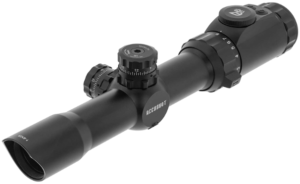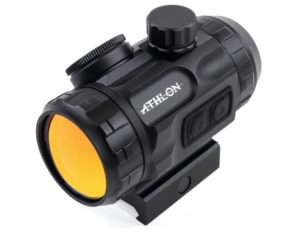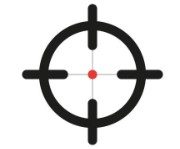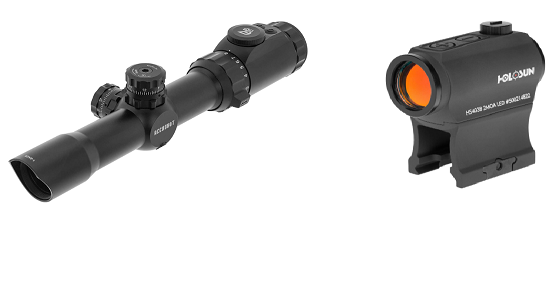Searching for the best home defense optic can be challenging, especially if you are a beginner. You need a durable optic with a low-profile design. This makes them less likely to get snagged on objects during high-stress scenarios.
Most avid shooters recommend LPVOs or red dots for home defense. This is because they are designed for fast-paced shooting applications.
Low Power Variable Optics and red dots offer quick target acquisition and easy-to-see aiming points. LPVOs allow for quick adjustments to the magnification, making them ideal for engaging close-range targets. In addition, they come with illuminated reticles, which make it easy to acquire targets in low-light conditions.
On the other hand, red dot sights offer a wide field of view and unlimited eye relief. Therefore, you can engage targets with both eyes open for improved situational awareness. This is why they are also ideal for home defense. They are also easy to use, requiring less time to get up and running.
Other optics ideal for home defense is prism and holographic sights. They also make it easy to scan a room and locate potential threats.
In this post, we will take a closer look at LPVOs and red dots and how they relate to home defense. We will examine the pros and cons to help you make an informed purchase.
Let us get right into it.
What is an LPVO
 A Low Power Variable Optic is a riflescope designed to engage close and long-range targets. This is because you can adjust the magnification from 1x to a maximum power range of 4x, 5x, 6x, 8x, or 10x.
A Low Power Variable Optic is a riflescope designed to engage close and long-range targets. This is because you can adjust the magnification from 1x to a maximum power range of 4x, 5x, 6x, 8x, or 10x.
LPVOs work like traditional sights but come with a bullet drop to compensate for the reticle. This helps to eliminate any guesswork in your shooting applications. This is why most avid shooters recommend them for home defense.
The exceptional feature of LPVOs is the coated lenses that improve image clarity. The coating also ensures the lenses are fog proof and waterproof.
LPVOs are made from durable materials to withstand heavy recoil and impact. You can quickly secure the optic to your rifle by following simple steps in the instructions manual.
The other exceptional feature is that LPVOs are illuminated. This is why they are suitable for engaging targets in low-lighting conditions.
However, LPVOs need proper training to use them effectively, especially if you have not handled scopes before. Therefore, they might not be the ideal optic for you if you are a beginner.
The other downside is that it might take time to adjust when aiming at a moving target.
Pros
- They are ideal for close to long-range shooting applications.
- They use a first focal plane reticle that allows you to make holdover and windage corrections across all magnification levels.
- They have a wide field of view that allows the shooter to acquire long-range targets.
- The reticle is illuminated, allowing you to use it in low-lighting conditions.
- They provide high-quality images, making it easy to acquire targets even at high magnification levels.
- Some options come with an adjustable objective lens that allows you to fine-tune the focus.
- They come with windage and elevation adjustments.
- They are durable and long-lasting compared to red dot sights.
Cons
- They are more expensive than red dot sights.
- They have limited eye relief.
- They are heavy than red dots, which might affect stability.
What is a Red Dot?
 A red dot is a 1x optic designed to engage close to medium-range targets. They are popular because they have a compact and lightweight design, making them ideal for small firearms like handguns.
A red dot is a 1x optic designed to engage close to medium-range targets. They are popular because they have a compact and lightweight design, making them ideal for small firearms like handguns.
The exceptional feature of red dots is the low profile design. They are also very easy to use because they do not require any special adjustments. All you need to do is look through the lens to acquire targets.
In addition, red dots are ideal for shooters who wear prescription glasses. This is because they have unlimited eye relief, allowing you to shoot with both eyes open.
Red dot sights are very easy to mount. They are also compatible with many firearms, including rifles, shotguns, and handguns.
The only downside of red dot sights is that they are not durable compared to LPVOs. In addition, they are battery dependent.
Let us look at the pros and cons.
Pros
- They are compatible with a wide range of firearms.
- They help to improve target acquisition.
- The lenses are coated to improve image clarity.
- They are fog proof, waterproof, and shockproof.
- Red dots are ideal for shooters who wear prescription glasses.
- They are durable.
Cons
- They are battery dependent.
- They are not ideal for engaging long-range targets.
- Some red dots have parallax issues.
Frequently Asked Questions on LPVO vs Red Dot Home Defense
- Do Red Dot sights require batteries?
Yes, Red Dot sights require batteries to operate. However, the type of battery and the battery life varies depending on the specific model of sight. It’s important to check the battery life regularly and have spare batteries on hand, especially when hunting. Some red dots have a battery saver mode, turning off the sight when not in use, conserving battery life and avoiding accidental discharge.
- What is the difference between LPVO and Red Dot sights?
LPVOs offer variable magnification and are designed for longer-range shooting, while red dots have a wide field of view and are designed for quick target acquisition and ease of use at close range.
- What are the advantages of red dots for home defense?
Red dots are very easy to use and are designed for fast-paced shooting applications. They have a wide field of view, making locating and tracking targets easy. They can be used with both eyes open, improving situational awareness, and are usually durable and have a low profile.
- What are the benefits of using LPVOs for home defense?
LPVOs offer versatility, allowing for quick adjustments to the magnification for different shooting scenarios. This makes them ideal for shooting at both close and long ranges. They often have an illuminated reticle, making them usable in low light conditions, and many models have a first focal plane reticle, allowing for accurate holdovers at any magnification.
Conclusion
In this LPVO vs red dot home defense comparison, we have a look at the important features, pros and cons to help you make an informed purchase. Red dots are clearly the best option because they are specifically designed for fast-paced situations like home defense.
However, if you want to engage close and long-range targets, we recommend buying a Low Variable Power Optic. The only downside is that they are more expensive than most red dots.
Ultimately, you must choose an optic that suits your shooting requirements. Each optic has its own set of pros and cons. Pick an optic that will provide value for the money you spend.
We hope this post helped you learn more about LPVOs and red dots for home defense. You can also check Red Dot Vs Holographic.

